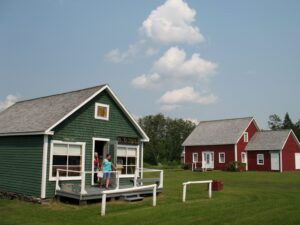
February 20, 2020 Van Buren
While we still have a good two months left of winter before the spring season comes about, now is as good a time as ever to plan spring trips to get out of the house and shake off the winter blues! Head up to Aroostook County and stop by beautiful Van Buren!
Van Buren, a small town of just over 2,000 people, enjoys stunning views of the St. John river. Located just this side of the Canadian border from Saint Leonard, New Brunswick, Van Buren has a rich history spanning centuries and countries. Originally part of British-settled area in what is now New Brunswick, the settlement became part of Maine out of the Webster-Ashburton Treaty. Signed in 1842, it settled the border dispute between Great Britain and the United States of America in the area that is now Aroostook County. Previously called Violette Brook, it then became Van Buren Plantation, named after the 8th President of the United States, Martin Van Buren.

Van Buren was home to mills and factories in the late 19th century. By the early 20th century, the Bangor and Aroostook Railroad had made its way to the area. The railroad allowed for more significant movement of goods and people from the southern part of the state. In 1881, the town was incorporated as the Town of Van Buren.
Van Buren celebrates its rich Acadian history widely. A museum of preserved Acadian houses forms a settlement available to visit by the public. The settlement aims to exemplify what life was like when Acadians lived in the area; many of their descendants still live in town and the surrounding areas!
Today, about three-quarters of the population of the town still speak French casually. While not a large town, it has much to offer for those who know where to look. If you are staying overnight, Aroostook Hospitality Inn offers comfortable and clean lodging. Tasty Food provides comfort food to make one really feel at home. At night, if you’re lucky, you might see the northern lights dancing across the sky. Bathing the area in flows of green and pink, the auroras tie the area together in a blanket of wonder and awe.

Inevitably one will find themselves gazing across the St. John, admiring the sheer beauty of this area that so many call home. It isn’t hard to see that those on both sides of the river have a lot in common; a shared history, livelihood, and pride in locality, despite the national border.

